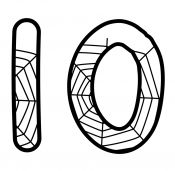Comhaireamh Síos Go hOíche Shamhna (Countdown to Halloween) Posted by róislín on Oct 9, 2012 in Irish Language
(le Róislín)
Bhuel, it’s not exactly a “comhaireamh síos” [KOH-irzh-uv sheess] as such, but here’s a sampler of focail le téama Oíche Shamhna (Halloween-themed words) that might be a fun way to practice counting in Irish. With Irish numbers, you don’t just have to learn the numbers themselves, but also the ever-present mutations that follow them.
In a nutshell, the rialacha (rules) are, with a very basic example, “bosca,” to show the changes :
for one item: just the noun, or the noun followed by “amháin” (that “followed by” is important because all the other numbers come before the noun): bosca OR bosca amháin, mar shampla
for two items: dhá plus lenition (inserting an “h” after the initial consonant): dhá bhosca
for three, four, five, or six items: trí, ceithre, cúig, or sé, plus lenition: trí bhosca, ceithre bhosca, cúig bhosca, sé bhosca
for seven, eight, nine, or ten items: seacht, ocht, naoi, or deich, plus eclipsis (covering over the original first consonant with another letter, in this case “m” in front of the “b,” giving us “mb”): seacht mbosca, ocht mbosca, naoi mbosca, deich mbosca (say “MOS-kuh” for all the eclipsed versions–the “b” is now silent)
And now for some examples pertaining to Oíche Shamhna [“EE-hyuh HOW-nuh, with “how” as in English “how” or “now,” not like the English “ow” as in “snow” or “tow”]
taibhse amháin [TAIV-shuh uh-WAW-in, with the “ai” like “pie” or “eye,” not like “rain”]: one ghost
dhá ialtóg [γaw EELT-ohg; that first letter is the gamma sign, signifying the throaty pronunciation, sort of like the “ch” in “Chutzpah” but lower down in the throat–it’s our old friend the voiced velar fricative, for those who are interested in the linguistic details]: two bats
trí phuimcín [trzhee FWIM-keen]: three pumpkins
ceithre starrfhiacail [KyEH-ruh STAR-EE-uh-kil, note that “st” never gets lenited and that the “fh” is completely silent]: four fangs (tá súil agam go bhfuil siad déanta as céir — I hope they’re made of wax)
cúig thurnapa [KOO-ig HUR-nuh-puh]: five turnips (for those who endorse the pre-pumpkin “Jack-O-Lantern”). An scéal go hiomlán faoi Jack? Blag éigin eile!
sé choinneal [shay KHIN-yawl]: six candles (in case “coinneal Jeaic” burns out!)
seacht gculaith [shakht GUL-ee]: seven costumes. Remember, the noun stays singular after numbers in Irish, so we don’t use the plural, cultacha (costumes). It’s an irregular plural, though, and good to know (culaith, singular; cultacha, costumes).
ocht laindéar [okht LAN-djayr]: eight lanterns (no eclipsis because “laindéar” starts with “l,” which is non-eclipsable)
naoi ndamhán alla [nee NOW-awn AH-luh]: nine spiders
deich dtarantúla [NB: “dt” pronounced like “d,” as “dar”]: ten tarantulas, just to ratchet up the big-black-spideriness of the season! Now there’s a word I’ve never seen in Irish before — spideriness! I’ll have to check up on that one. Presumably one could say “*damhán-allachas,” or something like that, but it’s a little tricky creating the “-ness” form, since “spider” is already a 2-word phrase in Irish (damhán alla, which literally means “little wild ox,” yes, “ox,” which in Irish is “damh“). And I guess there could be non-Halloween applications, like describing scríbhneoireacht (handwriting). Normally, though, we’d just say “scríbhneoireacht chaolchrúbach,” which literally means “narrow-clawed” or “narrow-awkward” writing. In other words, “spidery handwriting” isn’t traditionally described as “spidery” as such in Irish. But there’s no reason why it couldn’t be. Just ask Charlotte!
You might have noticed that I avoided listing human-type beings here, except for “taibhse amháin” (one ghost). Any thoughts as to why I’m saving that for another blog?
Got it? Maybe? If not, here’s a clue. Counting people in Irish takes the so-called “personal number” form, which is different from the actual cardinal number. I’m debating whether vaimpirí and gúil should be considered as people for this purpose. Fans of Twilight will no doubt say yes! At any rate, doing the “uimhreacha pearsanta” will take at least another blog, so “ghoulies” and “ghosties,” please be patient. And “long-leggity beasties” too.
SGF, Róislín
Grafaicí (uimhreacha líon damhán alla): Graphics From the Pond http://frompond.blogspot.com
P.S. Sin fíorscríbhneoireacht “aracnóideach” thuas, nach ea?

Build vocabulary, practice pronunciation, and more with Transparent Language Online. Available anytime, anywhere, on any device.





Leave a comment: